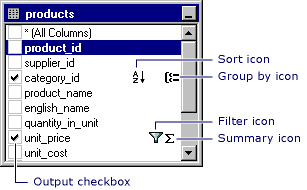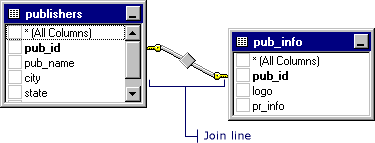 Overview of the Diagram pane
Overview of the Diagram pane Overview of the Diagram pane
Overview of the Diagram pane
The Diagram pane presents a graphic display of the tables, views, user-defined functions, or subqueries in your query. It also shows any join relationships among them.
In the Diagram pane you can:
When you make a change in the Diagram pane, the Grid pane and SQL pane are updated to reflect your change. For example, if you select a column for output in a table, view, user-defined function, or subquery window in the Diagram pane, the Query Designer adds the data column to the Grid pane and to the SQL statement in the SQL pane.
 About the Diagram pane icons, check boxes, and symbols
About the Diagram pane icons, check boxes, and symbols
Each table, view, user-defined function, or subquery appears as a separate window in the Diagram pane. The icon in the title bar of each rectangle indicates what type of object the rectangle represents, as illustrated in the following table.
| Icon | Object type |
|---|---|
 |
Table |
 |
View |
| In-line Function | |
 |
Subquery (in FROM clause) |

The following table lists the check boxes and symbols used in the rectangle for each table, view, or user-defined function.
| Check box or symbol | Description |
|---|---|
    |
Specifies whether a data column appears in the query result set (Select query) or is used in an Update, Append, Make- Table, or Append Values query. Select the column to add it to the results. If (All Columns) is selected, all data columns appear in the output.
The icon used with the check box changes according to the type of query you are creating. When creating a Delete query, you cannot select individual columns. |
  |
Indicates that the data column is being used to order the query results (is part of an ORDER BY clause). The icon appears as A-Z if the sort order is ascending or Z-A if sort order is descending. |
 |
Indicates that the data column is being used to create a grouped result set (is part of a GROUP BY clause) in an aggregate query. |
 |
Indicates that the data column is included in a search condition for the query (is part of a WHERE or HAVING clause). |
 |
Indicates that the contents of the data column are being summarized for output (are included in a SUM, AVG, or other aggregate function). |
 Joined tables on the Diagram pane
Joined tables on the Diagram pane
If the query involves a join, a join line appears between the data columns involved in the join. If the joined data columns are not displayed (for example, the table, view, user-defined function, or subquery window is minimized or the join involves an expression), the Query Designer places the join line in the title bar of the rectangle representing the table, view, user-defined function, or subquery. The Query Designer displays one join line for each join condition.

The shape of the icon in the middle of the join line indicates how the tables or table-structured objects are joined. If the join clause uses an operator other than equal (=), the operator is displayed in the join line icon. The following table lists the icons that can be displayed in a join line.
| Join line icon | Description |
|---|---|
 |
Inner join (created using equal sign). |
 |
Inner join based on the "greater than" operator. (The operator displayed in the join line icon reflects the operator used in the join.) |
 |
Outer join in which all rows from the table represented on the left will be included, even if they do not have matches in the related table. |
 |
Outer join in which all rows from the table represented on the right will be included, even if they do not have matches in the related table. |
 |
A full outer join in which all rows from both tables will be included, even if they do not have matches in the related table, view, user-defined function, or subquery. |
| Icon on ends of join line | Description |
|---|---|
 |
One-to-one join |
 |
One-to-many join |
 |
Query Designer cannot determine join type |